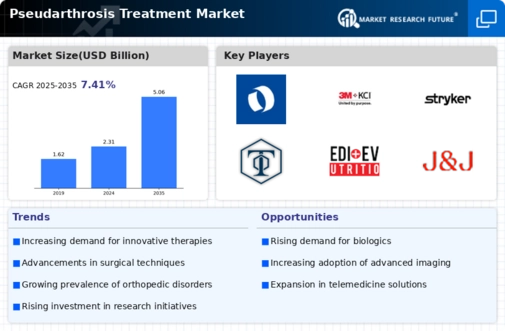Increasing Awareness and Education
Raising awareness about pseudarthrosis and its treatment options is becoming a crucial driver for the Pseudarthrosis Treatment Market. Educational initiatives aimed at both healthcare professionals and patients are essential for improving diagnosis and treatment rates. As awareness grows, more individuals are likely to seek medical attention for symptoms associated with pseudarthrosis, leading to earlier interventions. Furthermore, healthcare providers are increasingly emphasizing the importance of patient education regarding treatment options and potential outcomes. This shift in focus is expected to enhance patient engagement and adherence to treatment plans, ultimately contributing to better health outcomes. Consequently, the Pseudarthrosis Treatment Market is poised for growth as awareness campaigns continue to expand.
Rising Incidence of Pseudarthrosis
The increasing prevalence of pseudarthrosis is a primary driver for the Pseudarthrosis Treatment Market. Factors such as aging populations and higher rates of trauma-related injuries contribute to this rise. According to recent data, the incidence of pseudarthrosis is estimated to affect approximately 5 to 10% of patients undergoing orthopedic surgeries. This growing patient population necessitates effective treatment options, thereby propelling market growth. Furthermore, the demand for innovative therapies and surgical interventions is likely to increase as healthcare providers seek to address the complexities associated with pseudarthrosis. As a result, the Pseudarthrosis Treatment Market is expected to expand, driven by the need for advanced solutions that can improve patient outcomes and reduce the burden of this condition.
Advancements in Surgical Techniques
Innovations in surgical techniques are significantly influencing the Pseudarthrosis Treatment Market. Minimally invasive procedures, robotic-assisted surgeries, and enhanced fixation methods are becoming more prevalent, leading to improved patient recovery times and outcomes. These advancements not only reduce the risk of complications but also enhance the overall effectiveness of treatments for pseudarthrosis. The introduction of new technologies, such as bioactive materials and improved imaging techniques, further supports the evolution of surgical practices. As healthcare professionals adopt these advanced methodologies, the demand for specialized training and equipment is likely to rise, thereby driving growth in the Pseudarthrosis Treatment Market. The integration of these innovations is expected to lead to better surgical results and increased patient satisfaction.
Regulatory Support for Innovative Therapies
Regulatory bodies are increasingly supporting the development and approval of innovative therapies for pseudarthrosis, which serves as a significant driver for the Pseudarthrosis Treatment Market. Streamlined approval processes and incentives for the development of new treatments are encouraging companies to invest in novel solutions. Recent regulatory changes have facilitated faster access to market for breakthrough therapies, which is likely to enhance competition and innovation within the industry. As a result, patients may benefit from a wider array of treatment options that are both effective and safe. This supportive regulatory environment is expected to foster growth in the Pseudarthrosis Treatment Market, as companies strive to meet the evolving needs of patients and healthcare providers.
Growing Investment in Research and Development
The Pseudarthrosis Treatment Market is experiencing a surge in investment directed towards research and development. Pharmaceutical companies and medical device manufacturers are increasingly focusing on developing novel therapies and products aimed at treating pseudarthrosis. This trend is supported by the recognition of the condition's complexity and the need for effective solutions. Recent reports indicate that R&D spending in the orthopedic sector has seen a notable increase, with projections suggesting a compound annual growth rate of over 5% in the coming years. This influx of funding is likely to accelerate the development of innovative treatment options, including biologics and advanced surgical techniques, thereby enhancing the overall landscape of the Pseudarthrosis Treatment Market.


















Leave a Comment